Reproduction
Reproduction is the process by which living organisms produce new individuals similar to themselves. Reproduction ensures the continuation of life on earth. Reproducing organisms create new similar individuals leading to increase in their population, thus preventing the organisms from becoming extinct.
Why do organisms reproduce?
- Addition of new species
- Replacing the dead organism
- Continuation of race of species.
Do organisms Create exact copies of themselves?
Every organism is made up of a single cell and each cell has a chromosome in the nucleus. These chromosomes have DNA. The DNA (deoxyribonucleic acid) is responsible for the transfer of characters from parents to offspring. During the process of reproduction the reproductive cells produce two copies of DNA which separate into two cells which will be similar but non identical to each other as this is a biochemical process which may not be reliable and will lead to variations. As a result the new offspring will have slight differences from their parents which forms the basis for variations and evolution of new species.
Also Check – What is the importance of dna copying in Reproduction ?
Also Check- Variation and its importance
Also Check – Why is variation Beneficial to the species but not necessarily for the individual ?
Types of Reproduction
There are two major types of reproduction:
- Sexual reproduction
- Asexual reprodution
Asexual Reproduction
Asexual reproduction is the most simplest type of reproduction involving only one parent. In this form of reproduction, two or more offspring are produced by the same organism without the fusion of gametes. It is very common in unicellular organisms.
The offspring produced are genetically and physically similar to each other. Example: Amoeba, Hydra etc.
Characteristics of Asexual reproduction
- It is a simple and rapid method of reproduction
- No involvement of gametes.
- It doesn’t lead to evolution.
- Cell division takes place either mitotically or amitotically.
- The offspring produced are genetically and physically similar to each other.
- A single parent is involved.
Sexual reproduction
Sexual reproduction is the type of reproduction where the new generation is produced by fusion of gametes from two parents(one male and one female).
This type of reproduction leads to some variation in the offspring. Examples: Humans, dogs, cats etc.
Characteristics of Sexual reproduction
- It is a complex and lengthy method of reproduction.
- There is fusion of male and female gametes leading to fertilization.
- The Cell division involves meiosis at some stages, especially during gamete formation.
- The offspring produced are not genetically and physically similar to each other.
- It increases the chance of genetic variation.
Also Check – Difference between sexual and asexual reproduction.
Modes of Asexual Reproduction
There are different modes of asexual reproduction through which organism reproduce:
5 Types of Asexual Reproduction
1. FISSION:
- The term fission means “splitting”.
- It is a process of reproduction in which a parent (unicellular organism) organism splits or divides into one or more identical daughter cells.
- It is the most common and simplest method of asexual reproduction in unicllular organisms.
- Example: bacteria, protozoans, some fungi,etc
It is of two types:
Binary fission
Multiple fission
Binary fission:
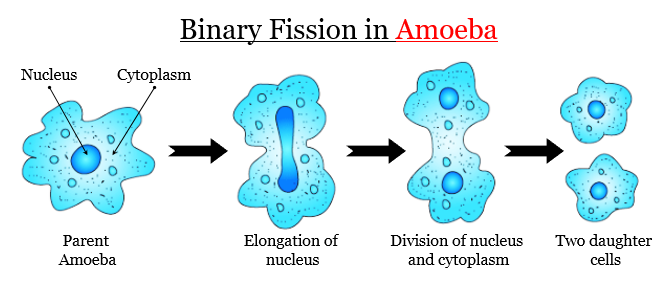
It is the division of one cell into two or more identical cells with a definite orientation. Example: amoeba . Read More …
Multiple fission:
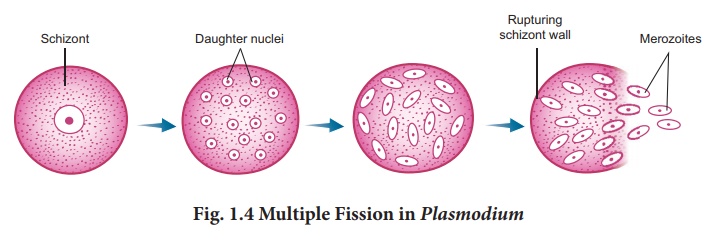
In this type of fission the parent cell divides into many identical cells at the same time. It occurs during unfavorable conditions. Example: Plasmodium (a malarial parasite). Multiple fission is also called schizogony. Read more…
How does Binary Fission differ from multiple Fission? ..Read more
| Binary Fission | Multiple Fission |
| It occurs during favorable conditions | It occurs during unfavorable conditions |
| Parent cell is divided into two daughter cells. | Parent cell is divided into many daughter cells. |
| No protective covering is formed | A protective covering cyst is formed |
| Nucleus divides only once | Nucleus divides repeatedly to form a number of nuclei. |
| Example: amoeba | Example: Plasmodium |
2. Fragmentation
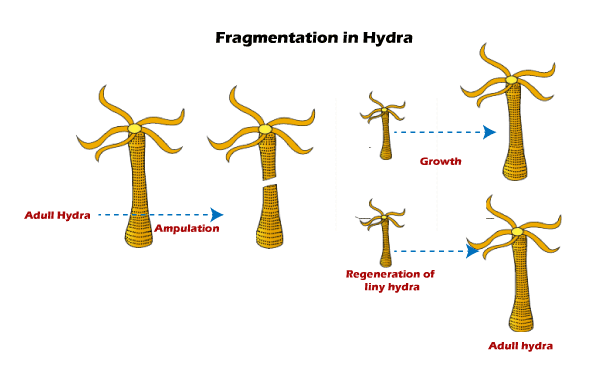
Fragmentation is a mode of asexual reproduction in which the parent cell breaks down into smaller pieces or fragments. Each fragment then develops into a complete new organism. It is found in multicellular organisms having simple body structure. Read more …
Example: Spirogyra, hydra, sea anemone.
3. Regeneration
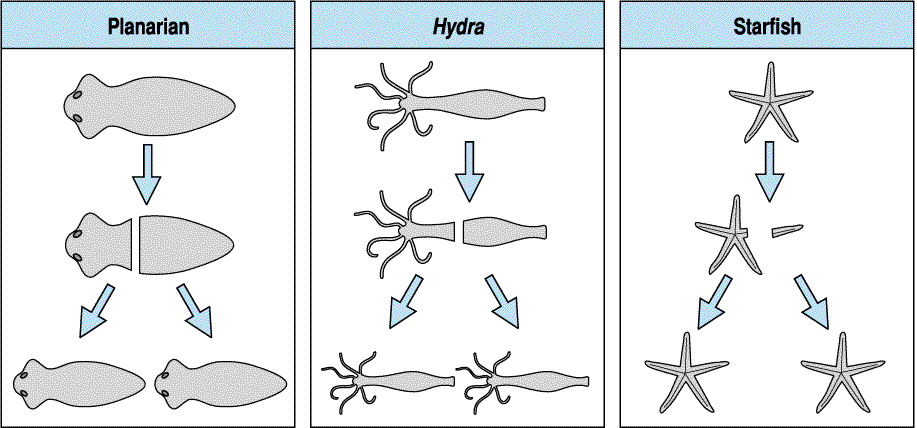
Growing a new organism from a lost body part is regeneration. Some organisms have an ability to give rise to new organisms from their broken or cutted body parts. These specialized cells are capable of redividing into a mass of cells from which they can differentiate into different types of cells and tissues . example: Planaria, Hydra. Read More….
ALSO CHECK- Difference between Fragmentation and Regeneration
Why can more complex organisms not give rise to new individuals through regeneration ?
4. Budding
This type of asexual reproduction begins by developing a small bud outside the parent organism. In budding a new organism is produced from the small projection called buds. When a parent cell divides, one of its nuclei moves into the outgrowth, which grows larger and eventually separates to lead an independent existence. Example: Hydra, Yeast (a fungus). Read more…
5. Vegetative Propagation
It is a asexual reproduction in plants where new plants are reproduced from detached vegetative parts of parent plant like roots, stem and leaves under favourable conditions. This is called as vegetative propagation. For example, potato tubers, runners etc. Read more….
It is of two types:
1. Natural Vegetative Propagation :
It is a type of asexual reproduction in plants where new plants are grown without any human interference. They propagate from parts like stem, roots, leaves etc.
- By roots: sweet potato
- By stems: potato
- By leaves: bryophyllum
Artificial Vegetative Propagation :
It is a type of asexual reproduction in plants where new plants are grown by humans on labs and fields . The new plant is genetically similar to the parent plant. The various types are:
- By cutting: in this type a part of the plant(stem,leaves) are cut from the parent plant and planted in the soil. The new plant is developed from the cutting. Example: Rose.
- Grafting: In grafting, cutting from one part of a plant (scion) is attached to the stem of the plant grown in the ground (stock). Example: lemon, grapes, mango etc.
- Layering: It is a type of vegetative propagation where the stem of one plant is bent and covered with soil from which adventitious roots develop and eventually will become a complete new plant. This method has a high success rate. Example: climbing roses, honeysuckle.
Spore Formation
In this type of asexual reproduction, offsprings are produced through reproductive structures called spores. Spores are defined as asexually reproducing bodies having a thick protective wall produced during unfavourable conditions. These spores or cells can reproduce into a new organism when they come in contact with a suitable medium like moist surface. Example: Rhizopus (a fungus). Read More….
How will an Organism be Benefited if it reproduces through spores?
Reproduction through spores produces various benefits like:
- Spores can remain dormant till favorable conditions are available.
- Spores are covered with thick protective coats helping in survival during adverse conditions.
- It can be easily spread to water, air or any other places due to their light weight. Thus, it is good for spreading an organism to more places.
- Spore reproduction is quick and multiplies many at once. Hence the survival chances are high.
Tissue Culture
It is defined as a process of growing new plants using living tissues and cells of plants in a suitable medium using aseptic conditions. Read more …
The steps of tissue culture are:
Sexual Reproduction
Sexual reproduction is the type of reproduction where the new generation is produced by fusion of gametes from two parents(one male and one female). This type of reproduction leads to some variation in the offspring. Examples: Humans, dogs, cats etc.
Characteristics of Sexual reproduction
- It is a complex and lengthy method of reproduction.
- There is fusion of male and female gametes leading to fertilization.
- The Cell division involves meiosis at some stages, especially during gamete formation.
- The offspring produced are not genetically and physically similar to each other.
- It increases the chance of genetic variation.
Why the sexual mode of reproduction ?
- In sexual mode of reproduction two parents are involved.
- As two parents are involved the offspring will not be identical to the parents. It will have features of both the parents.
- Each parent passes their DNA copies through their nuclei at the time of fertilization of gametes.
- This process involves copying of DNA as well as the cell apparatus. The DNA copying mechanism cannot be absolutely accurate resulting in variation and diversity. This is the basis for evolution.
- Variation helps the organism adapt to harsh or new environmental conditions or changes for survival.
- It makes organisms better fitted for the struggle of existence.
Modes of sexual Reproduction
- In sexual reproduction two gametes (male and female) fuse together resulting in formation of a new cell called zygote.
- Simple organisms have almost similar size of germ cells that are not much different from each other.
- In complex organisms the size of germ cells varies differently.
- In these organisms, the germ cell with larger food storage is called female gamete.
- The smaller and motile germ cell is called the male gamete.
- The sexual reproduction involves two major process:
- Formation of gametes by meiosis
- Fusion of gametes
Zygote:
It is the fertilized egg that results from the fusion of female gamete(ovum) with the male gamete(sperm).
Gametes:
Gametes are specifically sex cells that have 23 chromosomes. They are of two types
- Female Gamete: They are also called eggs or ova. They are haploid cells(they have half-set of chromosomes) that, when fused during sexual reproduction with a male gamete (sperm), form a diploid zygote.
- Male Gamete : They are also called sperms. They are motile which enables them to move freely inside the female reproductive system.
Sexual Reproduction in flowering plants
As the name suggests this type of reproduction in plants involves the gametes(male and female). Here, pollen grains from another/same flower lands on the stigma through a process called pollination. The pollen then gets slipped into the ovary through a structure called a pollen tube and enters the ovule where it combines with female eggs to form a fertilized cell called as Zygote. This process of fusion of gametes to form zygote is called fertilization.
Bisexual flower: Plants those who have both male and female reproductive organs in the same flower are called bisexual flower. E.g: Hibiscus, lily, rose etc.
Unisexual flower: Plants that have either male or female reproductive organ in a flower are called as unisexual flower. E.g: Papaya, watermelon etc.
Also Check – How do Organisms Reproduce Class 10 Questions and Answers
Part of flowers
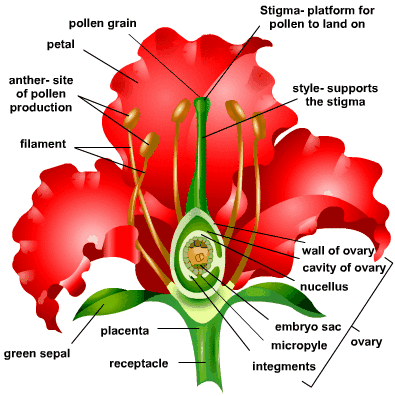
- Petals: petals are brightly coloured structures that give shapes and fragrances to the flower. It attracts insects towards the flower.
- Sepal: it is a small part that looks like leaves growing at the base of the flower.
- Pedicel: stalk or part of the stem that supports the flower.
- Stamen: it is the male organ of the flower. It is composed of two parts:
- Anthers: they are generally yellow coloured lobes that contain pollen sac for production of pollen grains.
- Filaments: it is the long thin stalk that holds anthers to the flowers
5) Pistils/Carpels: It is the female organ of the plant. It is composed of three sub parts:
- Stigma: it is the top most sticky part of pistil where the pollen grain lands.
- Style: it is the long stalk on which the stigma rests.
- Ovary: it is the swollen base of pistil at the bottom of a flower that contains ovules . ovules have flower eggs.
Pollination
Pollination is an essential part of plant reproduction. It is the main mode of sexual reproduction in plants. Pollination is the transfer of pollen grain from anther of the stamen to the stigma of a flower. The pollen grains are transferred by various agents (pollinators) like air, water, animals etc.
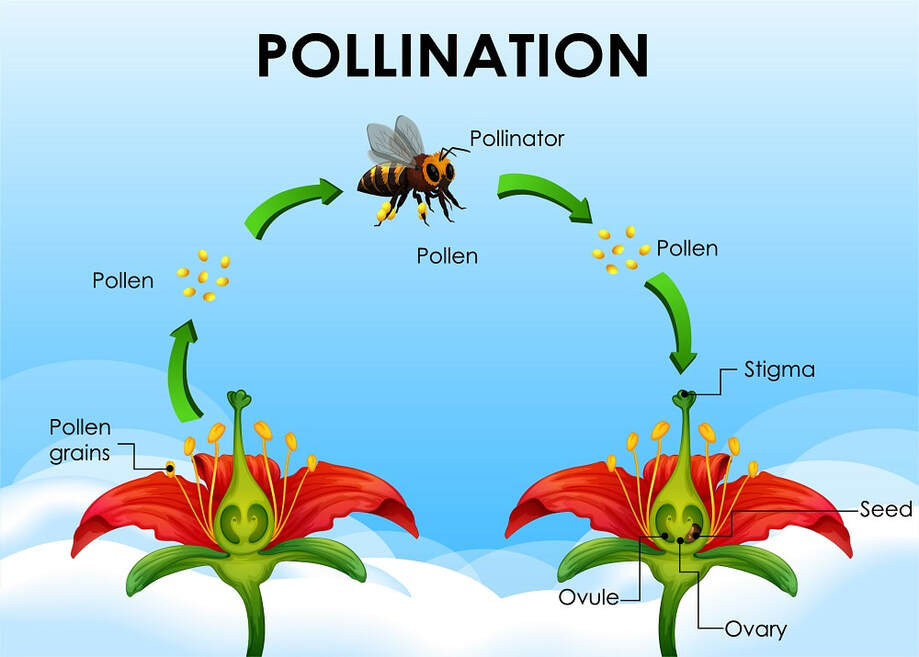
It is of two types:
- Self Pollination: it occurs within the same flower. Here the pollen from the stamen of a flower is transferred to the stigma of the same flower.
- Cross pollination: it occurs between two different flowers of the same species. Here the pollen from the stamen of a flower is transferred to the stigma of another flower.
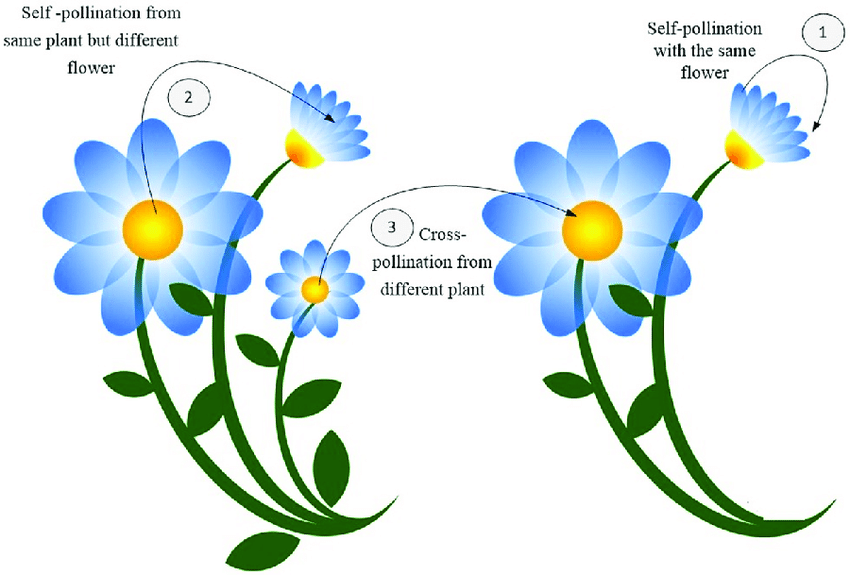
Fertilization
- After the process of pollination, fertilization occurs.
- It is defined as the process of fusion of male and female gametes to form zygote.
- The pollen grain which has landed on stigma then gets slipped into the ovary through a structure called a pollen tube.
- It enters the ovule where it combines with female eggs to form a fertilized cell called as Zygote.
- After fertilization, the zygote divide several times and forms an embryo within the ovule.
- The ovule changes into a seed and the ovary turns into a fruit. The rest of the parts of the flower dry up and then fall away.
- Under favorable conditions the seeds grow and develop into new plants.
Diffrence Between Pollination and Fertilization
| POLLINATION | FERTILIZATION |
| Pollination is the transfer of pollen grain from anther of the stamen to the stigma of a flower. | It is defined as the process of fusion of male and female gametes to form zygote. |
| It is an external process | It is an internal process |
| Pollination is followed by fertilization | Fertilization is followed by seed formation in plants or in animals birth of new offsprings. |
| It takes place only in plants | It takes place in both plants and animals. |
| It is a physical process | It is a biological process |
Also Check – How is the Process of Pollination Different from Fertilization ?
Germination
Seeds alone cannot transform into a plant. It needs proper conditions for its growth to form plants. The whole process of development of a seed into a baby plant is called germination. Seeds require enough water, air, sunlight, and good quality soil to develop into a plant. In early stages the seeds use the food stored in cotyledons to grow. The young plant that grows from seeds is called a seedling.
Reproduction in Human Beings
Reproductive Health
It is defined as a state of complete physical, mental and social well-being and not merely the absence of disease or infirmity, in all matters relating to the reproductive system and to its functions and processes (WHO). reproductive health implies healthy reproductive organs with normal functions. Reproductive health indicates that people have physically and functionally normal reproductive organs, as well as normal interactions with respect to behavior and emotion among them. Significance of reproductive health includes:
- It provides awareness to lead a healthy reproductive life.
- It provides knowledge regarding Sexually transmitted diseases and its prevention.
- It provides information regarding the importance of maintaining hygiene of genitals.
- It also teaches about family planning and the methods of contraception.
Sex Ratio
- It is defined as the number of females to the number of males in a population.
- The sex ratio of the population affects, and is affected by, birth, death, immigration, and emigration rates.
- The female -male sex ratio should be maintained to have a healthy society.
- Sex ratio is declining in some parts of the country due to the practice of female foeticide.
- Currently the sex ratio of India stands at 1,020 females per 1,000 males.
Also Check – How do Organisms Reproduce – Class 10 MCQ
Population Size
- Population size is the total number of organisms in a given area.
- The rate of birth and death in a given population determines its size.
- The population size increases if the number of births are higher than the number of deaths.
- The size of the human population is increasing continuously due to an increase in birth rate and a decrease in maternal, infant, and child mortality rates.
- The increasing population size makes it difficult to improve the standard of living.
- It will also result in over use of natural resources leading to its depletion.
Birth control
Birth control, also called contraception, is the prevention of pregnancy. The various methods used to prevent the occurence of pregnancy are called contraceptive or birth control methods. Birth control methods may work in a number of different ways:
- Preventing the meeting of sperm and eggs.
- Preventing the ovaries from releasing eggs that could be fertilized.
- Sterilization, which permanently prevents a person from getting pregnant.
Birth Control Methods :
| METHOD | EXAMPLE | DETAIL |
| Natural or Traditional | A)Periodic Abstinence B) Coitus interruptus C) Lactational amenorrhea | A) Here the couples prevent themselves from intercourse during the 10th and 17th day of the menstrual cycle called the fertile period.B)In this method, the male withdraws the penis from the vagina just before ejaculation, preventing the release of semen. C)This method occurs during the lactation period when the menstrual cycle is absent in the females, resulting in the decreased chances of pregnancy. |
| Barrier Methods | A) Condoms B) Diaphragm | A) that are made up of thin rubber or latex sheath that cover the penis in males while in the case of females they cover the cervix. -Also useful in preventing the transfer of STDs B) rubber cup that is placed in the vagina over the cervix. |
| Intra-uterine Devices (IUDs) | Lippes HoopesCopper-TProgestasert | -Devices that are inserted into the uterus of the females through the vagina.-these devices release copper and hormones into the uterus.- can cause side effects due to irritation of the uterus. |
| Hormonal | Oral contraceptive pills | – contain hormones, which prevents release of ovum, so that fertilization cannot occur. -they disturb the hormonal balance of the body.- can cause side effects also. |
| Injectable and Implants | NorplantDepo-Provera | -These are the combination of hormone either progesterone alone or both progesterone and estrogens. – These are taken by the females under the skin. |
| Surgical | Vasectomy Tubectomy | -It is a surgical procedure that cuts, blocks or closes the vas deferens. -It is a surgical procedure in which the fallopian tubes are cut, tied, or sealed. |
Female Foeticide
- Female foeticide is an abortion process in which a female foetus is removed from the mother’s womb before birth.
- The killing of an unborn girl child is female foeticide.
- Although this practice is illegal, many people still continue to practice it.
- The misuse of ultrasound to determine the gender of the fetus is contributing hugely to the increasing cases of female foeticide.


8 Comments on “How do Organisms Reproduce Class 10 -Notes”